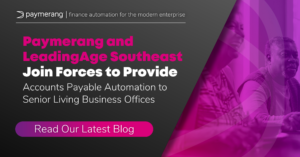8 Pillars of Holistic Automation
Recently, more Accounts Payable (AP) leaders have begun to recognize that finance automation can transform their AP departments into more efficient departments. While it’s tempting to use an automated system that replaces humans entirely, especially in the wake of overwhelming labor shortages, it’s important to remember that the key to optimizing AP lies in balancing people and technology.
Humans are the heroes of automation—so much so that McKinsey Global Institute projects that automation will create up to 83 million additional workers worldwide by 2030. By implementing automation and redefining roles in your organization, you keep humans “in the loop” and ensure your organization operates efficiently and cost effectively.
The best results are achieved when humans work cooperatively alongside automated systems. Partnering with best-in-class automation providers, which combine advanced technology with white-glove service, provides better results at each step of the payment lifecycle.
1. Implementation: No organization has the appetite for long or complicated system implementation. SaaS-based payment automation solutions, backed by white-glove service, are deployed fast, with minimal IT involvement, no impact on existing workflows, and seamless integration with any legacy accounting software, enterprise resource planning (ERP) application, or record system. As a result, these systems often can be implemented in five days or less, whereas traditional payment systems—which don’t leverage subject matter experts as part of their rollout process—can take months to deploy fully.
2. Spend analysis: The first step to achieving strong supplier adoption of electronic payments is the review an organization’s spend file, to see which suppliers accept electronic payments and how much spending they represent. Many suppliers already accept electronic payments and focusing enrollment efforts on these suppliers will deliver the biggest bang for the buck. Few AP departments have the time to perform this analysis. Fortunately, payment automation providers typically perform this analysis as part of their services.
3. Enrollment plan: Organizations have too much at stake to leave their migration to electronic payments to chance. That’s why it’s imperative to develop a plan to enroll suppliers in electronic payments. The plan must include a strategy for communicating the benefits of electronic payments to suppliers and convincing them to switch. And it must define project goals, rules of engagement for each supplier, critical action items, milestones, and a timeline. If this sounds like a lot of work, you are not mistaken. But a payment automation provider can develop and execute this plan as part of its white-glove service. What’s more, unlike many banks and Fintechs that only enroll suppliers for a short period of time, leading payment automation providers offer ongoing supplier enrollment, with every batch of supplier payments. This ensures optimal adoption, even as suppliers change.
Taking a ‘set it and forget it’ approach to payment automation can result in missed opportunities to migrate suppliers from paper checks as their needs and decision-makers change.
4. Supplier enablement: The cost to convert suppliers from paper checks to electronic payments is the top drawback to conversion. Once a supplier agrees to accept electronic payments, an AP department must collect the details needed to initiate payment. Paperwork must be completed, suppliers must be registered, and administrative tasks must be handled. And someone must oversee the entire enrollment process. AP teams shouldn’t have to take on this work. And they certainly shouldn’t have to bear the responsibility of collecting and storing sensitive banking details for all their suppliers. That’s why more AP departments are partnering with payment automation providers who offer best-in-class service.
Traditional payment automation solutions tend to limit services offered to suppliers.
5. Support: No one likes to feel like they are left holding the bag. But that’s what happens when suppliers cannot get timely help with updates to their payment preferences, changes to their banking details, issues with a payment, or questions on how they will receive payments and related data. One bad experience can have suppliers eager to return to paper checks, or worse, looking for the door. AP teams don’t always have the time or the expertise to respond to payment support issues. And suppliers don’t want to deal with an online support bot to get answers to something as important as their payments. Put the burden of responding to supplier support issues on the shoulders of a payment automation provider that offers white-glove service. Leading providers have more than 100 customer service representatives based in the U.S. who can respond to inquiries from suppliers or AP teams in 2 hours or less. The best payment automation providers will even follow-up with suppliers to ensure that all payments are processed, eliminating a potential reconciliation burden on AP departments.
Without white-glove support, all payment exceptions end up in your AP team’s lap.
6. Fraud: These days, the increased risk of fraud is the biggest concern that AP leaders have about the way their department is operating. The prolonged shift to remote working disrupted established policies and procedures for paying suppliers. AP departments can mitigate their risk of fraud by partnering with a payment solution provider that offers white-glove service. Each year, the internal security teams employed by these technology providers stop hundreds of fraud attacks against their clients, saving millions of dollars. If an AP department falls victim to an outside fraud attack – such as phishing or a Business Email Compromise (BEC) – the payment automation provider’s security team diligently monitors the organization’s payments for any suspicious or abnormal activity that might indicate fraud. And the security teams educate AP pros on an ongoing basis on how to mitigate fraud.
7. Business continuity: If there’s one lesson that organizations learned during the pandemic, it’s that they must be prepared for the unexpected. With no telling when or if AP teams will return to the office full-time, organizations can no longer rely on sending paper checks through the mail or storing reference documents in filing cabinets. Organizations must have tools for their AP teams to work effectively from anywhere. Payment automation enables business continuity by eliminating tasks and establishing role-based controls, and providing AP leaders with visibility across the enterprise, whether that means across an office building, across town, or across the globe.
8. Redefining AP: The operational benefits of AP automation are well documented. But an overlooked benefit of the technology is how replacing manual tasks frees staff to focus more time on fulfilling higher-value activities, such as collaborating with stakeholders to come up with solutions, building relationships with suppliers, analyzing complex data to uncover new early payment discount opportunities, and getting a clearer picture on the cost to pay suppliers. When you free your AP staff from mind-numbing tasks that have nothing to do with their finance expertise, you unlock their value and skills to improve the value they deliver to the organization.
No automated system is perfect, and humans will always be a crucial part of the payment lifecycle. Whether troubleshooting an unresponsive automation program or speaking with a vendor about a payment problem, an automated system that provides white-glove service will accomplish far more than an automated system alone.
Only when AP departments combine advanced technology with human workers will they achieve optimal benefits. Ultimately, by partnering with an AP automation provider, organizations can achieve faster payback, stronger supplier relationships, reduced risk of fraud, and better business continuity when keeping people at the center of automation.
To learn more, download the Value of Keeping Humans in the Loop in an Automated Environment White Paper by clicking here.




